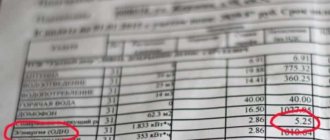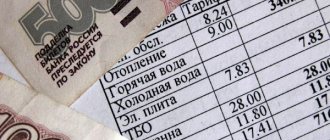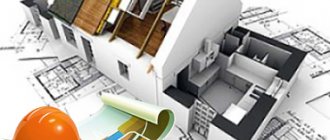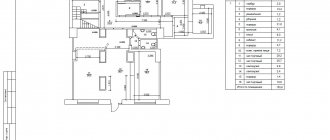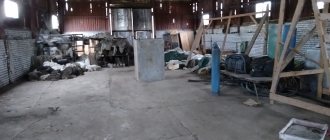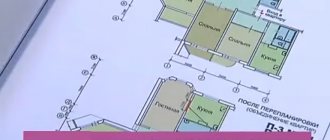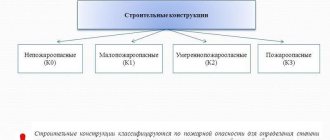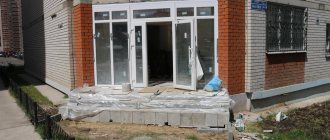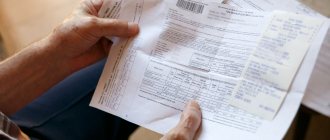There are two ways to determine the value of ODN in an apartment building: using a common building metering device and according to the standard. Below are examples of calculations for each case:
If there is a collective (common house) metering device in an apartment building
The volume of electricity provided during the billing period to the distribution network in an apartment building is in this case determined as the difference in the volume of electrical energy supplied to the apartment building and consumed by the owners (users) of residential and non-residential premises, which is distributed among consumers in proportion to the size of the total area of the premises owned by each consumer in an apartment building. Calculation of the amount of electricity payment for the billing period on a single-apartment building is carried out as follows (for example): 1. The volume of consumption is determined by the common building meter of an apartment building. Let’s say the volume of electricity determined from the readings of a common house meter was 4120 kWh; 2. The volume of electricity consumed by the distribution center of an apartment building is determined. Let us assume that the total volume of electricity consumption (according to meters and according to the standard) in residential and non-residential premises of the house was 3280 kWh. Then the volume of electrical energy consumed at the distribution center of an apartment building will be: 4120-3280 = 840 kWh; 3. The volume of electricity on one unit per apartment is determined: let’s say the area of your apartment is 44 sq.m/2766 sq.m (total area of all residential premises (apartments) and non-residential premises in an apartment building) * 840 kW*h = 13 kW* h; 4. The amount of payment for one-way service is calculated: 13 kW/h * 4.32 rubles/kWh = 56.16 rubles. At the same time, 4.32 rubles/kWh is a one-rate tariff for residential premises in a gasified apartment building, current for the first half of 2020 (Order of the Volgograd Region KTR dated December 20, 2019 No. 44/2). Thus, due to the fact that the volume of electricity consumption in the premises of an apartment building is different every month, the amount of payment for ODN per residential/non-residential premises will also vary every month. Regulatory framework: - clause 44 of the Rules for the provision of utility services to owners and users of premises in apartment buildings and residential buildings, approved by Decree of the Government of the Russian Federation of May 6, 2011 No. 354 “On the provision of utility services to owners and users of premises in apartment buildings and residential buildings."
If there is no collective (common house) metering device in an apartment building
The volume of electricity provided for the billing period to the distribution point in an apartment building is in this case determined as the product of the standard for common building needs by the area of common property with subsequent distribution among consumers in proportion to the size of the total area of the premises belonging to each consumer in the apartment building.
Calculation of the amount of electricity payment for the billing period for the one-room supply network is carried out as follows (for example): 1. Determine the value of the standard for the one-room supply network for an apartment building. Let's say the house is equipped with an elevator and is not equipped with electric heating and electric heating units for hot energy supply, then the standard will be equal to 2.6 kWh per month. per sq.m (Resolution of the Ministry of Fuel and Energy Tariffs of the Volgograd Region dated July 30, 2012 No. 5); 2. Total area of premises included in the common property in an apartment building = 320 sq.m; 3. The volume of electricity per unit per apartment is determined: 2.6 kWh per month. per sq.m * 526 sq.m * 44 sq.m (total area of the apartment)/2766 sq.m (total area of all residential premises (apartments) and non-residential premises in an apartment building) = 22 kWh; 4. The size of the fee for one-way service is calculated: 22 kW/h*4.32 RUR/kW*h = 95.04 RUR. At the same time, 4.32 rubles/kWh is a single-rate tariff for residential premises in a gasified apartment building, valid for the first half of 2021 (Order of the Volgograd Region KTR dated December 20, 2019 No. 44/2). When calculating ODN in an apartment building that is not equipped with a common building metering device, the readings of consumers' electricity meters, as well as the consumption of residential and non-residential premises determined by calculation methods, are not included. Regulatory framework: - clause 48 of the Rules for the provision of utility services to owners and users of premises in apartment buildings and residential buildings, approved by Decree of the Government of the Russian Federation of May 6, 2011 No. 354 “On the provision of utility services to owners and users of premises in apartment buildings and residential buildings."
The calculations use information about the areas of an apartment building, according to technical passports (explications) produced by the BTI, information about the areas of apartments - according to the technical passports of residential premises. If the area information used in the calculations is incorrect, please notify the guaranteeing supplier. The monthly calculation of your ODN volume and its breakdown are indicated in the sent payment document for the corresponding billing period.
Blog
Photo source: https://www.pexels.com/
It would seem that the concept of a communal resource for the maintenance of common property (KR SOI), introduced on January 1, 2021 instead of the concept of ODN (common house needs), has been in effect for almost 3 years, and all controversial issues should have been resolved and clarified during this time. But the Supreme Court of the Russian Federation likes to present new “surprises” in the form of interpretation of certain norms of housing legislation of the Russian Federation when considering controversial situations.
Often in legal disputes regarding the Kyrgyz Republic SOI, the question arises as to what areas should be correctly used for the purposes of calculating these costs. In this matter, the state housing supervision authorities (hereinafter - GZHN) are of the opinion that to calculate these areas it is necessary to adhere only to the technical passport data. But for several years now, urban planning regulations have not required the execution of this document upon completion of construction. However, most of the housing stock in the regions still consists of houses built from the last century, when every apartment building had to have a technical passport. It should, but it is not obliged... During the period of formation of legislation on housing and communal services, as well as wars for houses, long before the licensing of the activities of management organizations (MA), technical passports were not preserved by everyone and not everywhere.
And the content of these documents does not always reflect all the necessary information about the areas of apartment buildings. A document such as “MI 3290-2010 GSI. The recommendation for the preparation, execution and review of materials for testing measuring instruments for the purpose of type approval (with Amendments No. 1, 2, 3)” is still valid. And in paragraphs 24-26 of the Rules for the maintenance of common property of MKD, approved. By Decree of the Government of the Russian Federation No. 491 of June 13, 2006 (hereinafter referred to as Rule 491), there is no such document as the technical passport of the MKD, although there are references to it in regulatory legal acts (LLA), and in letters from the Ministry of Construction of the Russian Federation, and in court decisions.
In addition, given the absolute reluctance of the owners of apartment building premises to pay in an economically feasible amount for the services of management organizations, technical passports are updated practically by no one anywhere (very rarely). Although according to the law (clause 27 of Rule 491), technical documentation must contain up-to-date information. And this should be done at the expense of payment for the maintenance of common property (SOI) of the apartment building, that is, at the expense of the owners. But the prices for updating the technical passport of MKD are not at all childish, it is not clear where and from what they are calculated in organizations providing these services...
Also in the Letter of the Ministry of Construction and Housing and Communal Services of the Russian Federation dated April 11, 2021 No. 12368-A4/04
“On certain issues that arise when calculating the amount of payment for utilities for the purpose of maintaining common property in an apartment building” stated:
“...When calculating according to formula 26 of Appendix No. 2 to Rules No. 306, utility consumption standards for cold and hot water supply for common house needs, the total area of the premises that are part of the common property in an apartment building is taken into account, defined as the total area of the following premises that are not parts apartments of an apartment building and intended to serve more than one room in an apartment building ( according to the information specified in the passport of the apartment building): areas of inter-apartment landings, stairs, corridors, vestibules, halls, lobbies, wheelchairs, security (concierge) premises
in this apartment building that do not belong to individual owners.”
This is how the GZhN authorities interpret the data on the area of mKD for the purposes of calculating the KRSOI for water supply and sanitation. Although, by virtue of paragraph 1 of Art. 36 of the Housing Code of the Russian Federation, the common property of apartment buildings includes, among other things:
- premises in a given house that are not parts of apartments and are intended to serve more than one room in a given house, including inter-apartment landings, stairs, elevators, elevator and other shafts, corridors, technical floors, attics, basements
, in which there are engineering communications, other equipment serving more than one room in a given house (
technical basements
); - other premises in this house that do not belong to individual owners and are intended to meet the social and everyday needs of the owners of the premises in this house, including premises intended for organizing their leisure time, cultural development, children's creativity, physical education and sports and similar events
.
The composition of the Olympic Games is also contained in paragraph 2 of Rules 491, which also includes:
a) premises in an apartment building that are not parts of apartments and are intended to serve more than one residential and (or) non-residential premises in this apartment building (hereinafter referred to as common areas), including inter-apartment landings, stairs , elevators, elevators and other shafts, corridors, strollers, attics, technical floors
built-in garages and areas for motor transport, workshops, technical attics built
at the expense of the owners of the premises ) and
technical basements
, in which there are utilities,
garbage collection chambers, garbage chutes,
and other services serving more than one residential and (or) non-residential premises in an apartment building equipment (including
boiler rooms, boiler rooms, elevator units and other engineering equipment
).
In paragraph 29 of Government Decree No. 306 of May 23, 2006 “On approval of the Rules for establishing and determining standards for the consumption of utility services and standards for the consumption of utility resources for the purpose of maintaining common property in an apartment building” (hereinafter referred to as Rules 306), the consumption standards of KRSOI in MKD for each type of communal resources includes...also the volume of communal resources consumed in fulfilling the minimum list necessary to ensure proper maintenance of common property
in MKD services and works and
when using equipment included in the common property
, intended to provide favorable and safe living conditions for citizens.
If we turn to the minimum list of works for the maintenance of MKD, approved by Decree of the Government of the Russian Federation No. 290 of 04/03/2013 (hereinafter referred to as List 290), then it contains many types of work when water is used, and, accordingly, drainage.
Such work may also include: cleaning, washing the loading valves of waste chutes, the waste collection chamber and its equipment; cleaning the roof and drainage devices from dirt, flushing water supply sections after performing repair and construction work on the water supply system, flushing centralized heating systems to remove scale-corrosion deposits, flushing water supply systems to remove scale-corrosion deposits, watering lawns (green spaces) in summer.
Paragraph 23 of List 290 states that the maintenance work for premises that are part of the common property in an apartment building is as follows: dry and wet cleaning of vestibules, halls, corridors, galleries, elevator landings and elevator halls and cabins
, landings and flights, ramps; wet wiping of window sills, window grilles, stair railings, cabinets for electric meters of low-current devices, mailboxes, door frames, door leaves, closers, door handles; washing windows; cleaning of dirt protection systems (metal gratings, cellular coverings, pits, textile mats), and paragraph 24 of List 290 indicates washing trash cans near entrances.
Also, do not forget about cleaning after repairs in the entrances of apartment buildings. And the GZHN bodies and the courts very actively apply the Resolution of the State Construction Committee of the Russian Federation No. 170 of September 27, 2003 “On the approval of the Rules and Standards for the Technical Operation of the Housing Stock” (hereinafter referred to as Rules 170), the legality of the application of which is highly controversial.
For example, Rules 170 (clause 3.2.7) indicate washing the floor of staircases and flights, as well as sweeping the floor and walls, window sills, heating devices, etc., which should be done at least every five days, and walls - at least twice a year. In this case, wet cleaning of all surfaces must be done at least once a month.
Clause 3.3.1 states the responsibility of the management company to ensure cleanliness and accessibility of passage to all elements of the attic space, and clause 3.4.1 - cleanliness and accessibility of passage to all elements of the basement and technical underground. Clauses 3.6.10, 3.6.11 of Rules 170 also speak about the responsibility of the management authority to wash sidewalks, water them in hot weather at least 2 times a day., clauses 3.8.3, 3.9.1 - the obligation to ensure the safety of green spaces (lawns, flower beds, trees, shrubs), including their watering.
Clause 4.2.3.9 of Rule 170 establishes the obligation to clean and wash the facades of apartment buildings (there is even judicial practice on this matter), in clause 4.6.1.24. — cleaning of drains and drainage funnels, including rinsing with water. I wonder if all these works and areas are taken into account when setting standards for KRSOI? I think it's unlikely. But it’s easy to exclude and force a recount; this is in the spirit of the State Housing Inspectorate.
This is confirmed by the Ruling of the RF Armed Forces dated April 4, 2019 No. 306-ES19-3279.
After an inspection, the GZHN authority issued an order to the HOA about the incorrect accounting of the areas of the OI MKD, which were used to calculate the KR SOI for water supply and sanitation.
According to GZHN, when accruing for July 2021 to the owners of premises in an apartment building, the calculation of fees for utility resources ( cold water, hot water, wastewater disposal
), consumed for the maintenance of common property (in the payment document are displayed in the lines “Housing maintenance (cold water on the single service station)”, “Housing maintenance (hot water on the single distribution point)”, “Housing maintenance (water drainage on the single distribution point)”) is carried out taking into account the area premises indicated in the list of the composition of common property to determine standards for the consumption of these utility resources (it is necessary to
exclude from the calculation of this fee the area of engine rooms, elevators, waste bins, heating units (technical underground), fire exits)...
Of particular interest is the issue of elevators and waste bins, the washing of which is actually included in List 290. And the premises of heating units, technical subfloors, and fire exits must be kept clean, since they also belong to the OI MKD. Or, according to GZHN, can they never be washed at all? For dirt in elevators or in garbage bins, when checking the State Housing Authority, this fact will clearly indicate violations of Rules 491 and other regulations, and will easily draw up a protocol on an administrative offense for violation of licensing requirements and impose a fine.
Moreover, the order provides the following provisions of law to justify the illegality of applying the disputed calculation: clause 9 (in cassation and the Supreme Court - clause 9.1) of Art. 156 LC RF, paragraph 27 of Appendix No. 1 of Rules 306, paragraph 29 of Rules 491.
Article 156 of the RF Housing Code states:
Clause 9. Citizens recognized as low-income citizens in the manner prescribed by this Code and occupying residential premises under social tenancy agreements are exempt from paying fees for the use of residential premises (rental fees).
Clause 9.1. Payment for the maintenance of residential premises includes payment for utility resources consumed during the use and maintenance of common property in an apartment building, provided that the design features of the apartment building provide for the possibility of consuming the appropriate type of utility resources during the maintenance of common property,
determined in the manner established by the Government of the Russian Federation.
Clause 27 of Appendix No. 1 of Rule 306:
The total area of the premises that are part of the common property in an apartment building is determined as the total area of the following premises that are not parts of the apartments of the apartment building and are intended to serve more than one room in the apartment building (according to the information specified in the passport of the apartment building):
the area of inter-apartment staircases platforms, stairs, corridors, vestibules, halls, lobbies, strollers, security (concierge) premises in this apartment building that do not belong to the individual owner.
But, despite the obvious “jambs” of the supervisory authority in the legal justification of its order, the courts of all instances unanimously sided with the supervisory authority, without particularly bothering, based on their concepts only of Rules 306, which in general contradict the RF Housing Code in this matter and do not include all areas of the apartment building where water is consumed during work. The remaining premises and places in the MKD, in the opinion of the rule-makers, do not need water for the purposes of CRSOI. After all, our supervisory authorities are a priori right for the courts, no matter what sometimes crazy orders they issue.
In the Resolution of the Federal Antimonopoly Service of the Volga Region dated December 5, 2018 No. F06-39864/2018
in case No. A57-26118/2017 it is stated:
“...The courts came to the conclusion that the specified calculation of the area of common areas for determining the amount of payment for cold and hot water for the purpose of maintaining common property contradicts the Rules for establishing and determining standards for the consumption of utility services.
...Thus, the Government of the Russian Federation, for calculating the payment for hot and cold water at the service station of an apartment building, does not accept the areas of all premises named in Article 36 of the Housing Code of the Russian Federation; the list of them is individualized for the calculation of a specific service.
Having analyzed the circumstances of the case in conjunction with the evidence examined by the courts, the cassation court agrees with the conclusions of the lower courts that the inclusion of the areas of the disputed premises for payment for the consumption of these utility resources is unlawful.
Under such circumstances, the courts came to the correct conclusion that the contested order complies with the requirements of housing legislation and the absence of violations of the rights and legitimate interests of society in the field of business and other economic activities.”
The Ruling of the RF Armed Forces dated April 4, 2021 No. 306-ES19-3279 states:
“...At the same time, the courts found that the area of the premises of the named apartment building related to the common property is 5053.3 sq.m (in accordance with the technical passport - the area of stairs, corridors, wheelchairs
).
While the association in its calculation uses an area of 5816.2 sq.m., adding to the area of stairs, corridors, wheelchairs, the area of engine rooms, elevators, garbage bins, heating units (technical underground), fire exits
, which resulted in an overestimation of payments for utility resources consumed for the purpose of maintaining the common property of an apartment building.
...Taking into account the established circumstances, the courts recognized the contested order as complying with the norms of the current legislation and not violating the rights and legitimate interests of the association in the field of business activities. The arguments presented by the applicant were the subject of consideration by the courts and received a proper legal assessment.
The courts did not commit any significant violation of the norms of substantive law, as well as the requirements of procedural legislation that influenced the outcome of the trial. A different interpretation of the rules of law by the applicant does not indicate their incorrect application by the courts or a miscarriage of justice.”
This is the case, that is, elevators, garbage bins and other areas of the OI MKD, which, according to Rules 170 and List 290, require cleaning and washing, can now not be washed. But for some reason I am “plagued by vague doubts” that when it comes to the cleanliness of these places, supervisory authorities and courts will sharply change their opinion when considering cases to bring the management organization to administrative responsibility for violation of licensing requirements, expressed in violation of the Content Rules common property of the apartment building and other provisions of the law.
Sincerely, Ilmira Nosik.
continues to accept applications for the “Closed Branch 2020”.
The application and all the irrefutable information is here .
Payment Methods
There are several ways to pay for housing and communal services. Some of the common ones are:
- bank terminals and ATMs, the appropriate window is selected for payment and the amount is entered, as well as data on the payer;
- another way is to make a payment at a bank branch or through Russian post;
- you can use the bank’s application and transfer money from a bank card;
- Another way is to deposit money through Yandex. This service is the most popular.
If there are debts
If the debtor does not pay housing and communal services within 6 months, then the management company can file a lawsuit.
The first action from the management company will be a call warning that a payment needs to be made. As a threat, words about disconnecting utilities and taking the case to court can be used. Therefore, owners of non-residential premises need to monitor receipts and make payments on time.
Owners of non-residential premises, along with apartment owners, must pay payments on incoming receipts. This means that they have the same responsibility for payment as the owner of the apartment. Therefore, they can participate in a general house meeting or a meeting from the management company and resolve issues.
Should owners pay?
Today, most residential buildings share living space with shops, pharmacies and beauty salons.
Many tenants and owners of premises that do not belong to the residential category are concerned about the question of whether they are required to pay money for the provision of utility services on an equal basis with all residents in a residential building, or whether there is a separate payment method for them, and also what the amount of payments will be, for example, for electricity.
For the tenant
The rental of residential premises operates on the basis of a rental agreement between the tenant and the landlord. According to the terms of the agreement, the non-residential premises are for temporary use.
You have to pay for the square meters provided. In this case, payments must be made only for the use of the premises specified in the contract or for utilities. This will depend on the agreement between the owner, that is, the landlord and the tenant.
Most often, payments are still included in the rental price, but sometimes it happens that the lessor charges only the amount specified in the contract without any extra fees.
For the owner
Owners of premises not intended for residential use do not always know exactly what payments they will have to pay. In addition, if they are going to rent out non-residential premises, then the issue becomes even more complicated.
Since paragraph 1 of Article 290 of the Civil Code of the Russian Federation and paragraph 1 of Article 36 of the Housing Code of the Russian Federation state that the owners of non-residential premises, on an equal basis with the owners of apartments, own common use premises in shared ownership. These include:
- load-bearing structures in the house;
- electrical equipment;
- elevators;
- local area;
- sanitary communications;
- elements of landscaping and improvement.
Article 249 of the Civil Code of the Russian Federation assigns to each of the shared owners the right to dispose of property and make equal payments for its maintenance, that is, to pay taxes.
The norm established by Article 158 of the Housing Code of the Russian Federation obliges the owner of non-residential premises to bear the costs of the general maintenance of the premises that belong to him and to participate in general house fees if it is necessary to maintain equipment and other facilities, as well as communications in good condition.
The annual fee for non-residential premises consists of multiplying the following points:
- the cost of the premises, which takes into account the wear and tear of the building, this value is measured in rubles per sq. m. meter;
- coefficient of increase in expenses for construction and installation work;
- minimum comfort factor. It is taken as one if it is not a basement (0.25). For the absence of comfort elements, 0.1 point is deducted;
- the coefficient of increase in expenses due to construction work in a historical place;
- premium coefficient for construction and major repairs compared to the construction of new premises;
- coefficient of effective capital investment.
To the listed parameters is added depreciation, calculated for the year and measured in rubles/sq. meter.
According to the formula for calculating the fee, it is then necessary to add to the resulting amount the fee for renting the land plot where the non-residential premises are located.
This must then be multiplied by the inflation index and value added tax.
Tariffs and consumption standards
You have to pay for using energy resources. The amount of payment per unit of energy consumed is called a tariff. Tariffs are set either by the management company and must be agreed upon with the residents of the building, or by a meeting of residents called the homeowners' association.
If a definite decision on the tariff was not made at the meeting, then it will be established in accordance with Article 158 of the Housing Code of the Russian Federation.
Attention! In order to find out the standards, you need to refer to the receipt that arrives every month. Another way is to contact the Federal Tariff Service, which can clearly explain the standards set.
General house needs
ODN for cold water supply and sanitation: questions and answers
Your browser does not support HTML5 video.
Why should residents pay one payment for water?
The calculation of fees for one-room service is regulated by the Rules for the provision of utility services to owners and users of premises in apartment buildings and residential buildings in the Russian Federation. The standards for the consumption of cold and hot water and the disposal of wastewater for the purpose of SOI in apartment buildings in the Tomsk region are established by Order of the Department of Housing and Public Utilities and Civil Housing Services of the Tomsk Region No. 20 dated 05/31/2017.
In Tomsk, payment for single use services has been introduced since December 2021 in accordance with the approved Schedule of a phased transition to uniform standards for the consumption of utility services in the Tomsk region.
How is the TDS for water calculated?
In accordance with the Rules for the provision of utility services to owners and users of premises in apartment buildings and residential buildings in the Russian Federation, if there is no general public utility service in the building, the charge for public utility service is calculated using the formula:
ODN = Nodn * Smop * (Skv / Slived + Snonlived) * T, where:
Nodn – standard consumption of chemical substances, hot water and water for SOI purposes per 1 m2;
Smop – area of common areas excluding attics and basements;
Sq – total area of the apartment;
Sliv – the total area of all residential premises in the apartment building;
Snezhil – the total area of all non-residential premises in the apartment building;
T – tariff per 1 m3 of resource (HW, GW, VO).
If the house has an ODPU, the accrual of fees for ODPU is calculated using the formula:
ODN = (Vodpu - Vnon-residential - Vn lived - Vipu lived) * (Skv / Sresid + Snon-residential) * T, where
Vodpu – volume according to the administrative budget;
Vnon-residential – volume of consumption by non-residential premises;
Vn lived – volume of consumption by residential premises according to consumption standards;
Vipu lived – volume of consumption by residential premises according to IPU;
Sq – total area of the apartment;
Sliv – the total area of all residential premises in the apartment building;
Snezhil – the total area of all non-residential premises in the apartment building;
T – tariff per 1 m3 of resource (HW, GW, VO).
At the same time, the distributed volume of utility services provided to the ODN for the billing period cannot exceed the volume of utility services calculated based on the consumption standards of the corresponding KR at the SOI in the MKD.
What will be the order of the numbers? How much will an average family living in a 2-room apartment have to pay per month?
It all depends on the area of the apartment and the area of the MOP. The larger these values are, the higher the fee for one-time service. According to preliminary calculations, taking into account the established standards for the ADU of the average family living in a 2-room apartment (45 m2) in houses of standard construction, where there is a centralized HW, HW and VO, bathtubs 1.5-1.7 m long are installed, in a month for one tax will be charged in the range of 40 - 60 rubles.
If a metering device is installed in the house, IPUs are installed in all apartments, and readings are transmitted monthly, then the accrual for ODN will be significantly less or even equal to 0.
Will owners of non-residential premises pay ODT?
Owners of non-residential premises are also charged for ODN. The calculation scheme is identical (as for residential premises).
When will Tomsk residents receive their first payments?
LLC "Tomsk Settlement Center" (LLC "TRC") billed payment for ODN for December 2021 only to residents of apartment buildings where a direct form of management was chosen or the method of managing the house was not selected or not implemented. Bills were already sent to consumers in early January.
The remaining residents of apartment buildings of management companies and homeowners associations will be charged a fee in their bills for housing and communal services also from December 2021.
Where does the water intended for ODN go?
ODN is a payment for the water that entered the house, but was not sold to residents or owners of non-residential premises when calculated according to consumption standards and IPU. Previously, until September 2021, the established utility consumption standard contained these costs.
In accordance with the law, water for the distribution system in the house is spent on intra-house losses on networks, flushing communication networks, washing windows, staircases, interfloor areas, halls, strollers, watering flower beds and other needs.
How can you reduce charges for ODN?
- Install a common building metering device and insist on the installation of metering devices by all owners in their apartments. Strict accounting and savings lead to the absence of additional expenses for one-time tax;
- On time, once a month before the 25th, transmit readings from metering devices - both apartment and communal. This can be done by entering your readings into the invoice or reporting your readings by calling the SEC LLC, as well as in the Personal Account of the “Receipt on-line” service on our website: www.tomrc.ru;
- Adjust the plumbing in the apartment to avoid leaks;
- Demand that the management company or service organization put the basements in order. You pay for this work as part of your home maintenance payment!;
- Calculate “bad” apartments. Demand that this work be carried out by the management company, the HOA or the House Council, and report cases of illegal residence of citizens without registration. This is especially true with apartments for rent;
- Select a “house manager” who will contact the supplier on all issues that arise.
Official documents defining the procedure for charging for water, taking into account general household needs:
Decree of the Government of the Russian Federation No. 354 “On the provision of utility services to owners and users of premises in apartment buildings and residential buildings”
Decree of the Government of the Russian Federation No. 344 of April 16, 2013) “On amendments to certain acts of the Government of the Russian Federation on the provision of utility services”
Federal Law “On energy saving and increasing energy efficiency...” dated November 23, 2009 No. 261-FZ
Ministry of Regional Development: answers to questions on the application of Decree of the Government of the Russian Federation of May 6, 2011 No. 354.
Your browser does not support HTML5 video.
Your browser does not support HTML5 video.
Your browser does not support HTML5 video.
